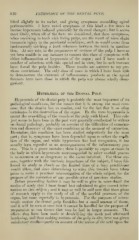Page 830 - My FlipBook
P. 830
840 PATHOLOGY OF THE DENTAL PULP.
lifted slightly in its socket, and giving symptoms resembling apical
pericementitis. I have noted symptoms of this kind a few times in
intense hyperemia induced primarily by thermal changes ; but it seems
most likely, when all of the facts are considered, that these symptoms,
when occurring in teeth with living pulps, are the result of some slight
traumatic injury to the peridental membrane, such as would occur from
inadvertently catching a hard substance betNseen the teeth in mastica-
tion. At any rate, in the preparation of sections of the pulp I have as
yet been unable in any instance to connect this class of symptoms M'ith
either inflammation or hyperemia of the organ ; and I have made a
number of selections with this special end in view^, but in each instance
have found the pulp healthy. These results are contrary to my pre-
vious convictions. The only class of cases in which I have been able
to demonstrate the existence of inflammatory products at the apical
foramen have been those in which the pulp was almost wholly disor-
ganized.
Hyperemia of the Dental Pulp.
Hyperseraia of the dental pulp is probably the most important of its
pathological conditions, for the reason that it is among the most com-
mon that the dentist has to combat, and for the fact that it so often
terminates in the destruction of the organ. By the term hyperaemia is
meant the over-filling of the vessels of the pulp with blood. This sub-
ject seems to have been in the past very generally overlooked by writers
on dental pathology, probably on account of the difficulties of examina-
tion and discovery of the exact conditions at the moment of extraction.
Heretofore, this condition has been studied subjectively for the most
part ; that is, symptoms have been depended upon to reflect the co^^di-
tion of the organ, and while hyperemia has had recognition, it has
usually been regarded as an accompaniment of the inflammatory pro-
cess. This is a grave mistake : there is probably no organ or tissue in
the body in which hyperaemia unaccompanied by other morbid process
is so common or so dangerous to the tissue involved. For these rea-
sons, together with the intrinsic importance of the subject, I have fol-
lowed its study as closely as the limited time of a busy practitioner
w^ould allow, and since determining to write this treatise have taken
pains to make a practical reinvestigation of the whole subject, for the
purpose of the correction of any possible error of previous studies.
Before proceeding farther it may be well to give in some detail the
modes of study that I have found best calculated to give correct infor-
mation on this subject ; and it may as well be said now that these ]>lans
of research apply to the study of all of the morbid processes of the
organ, but more especially to hyperaemia. For the purposes of micro-
scopic section the dental pulp furnishes but a small amount of tissue,
and it will be seen at once that it cannot be handled for the purpose of
preparation as can tissues that may be had in larger amounts. The
eff'orts that have been made at decalcifying the tooth and afterward
hardening, and then making sections of the pulp in situ, have not given
satisfactory results — partly on account of the action of the acid upon the


